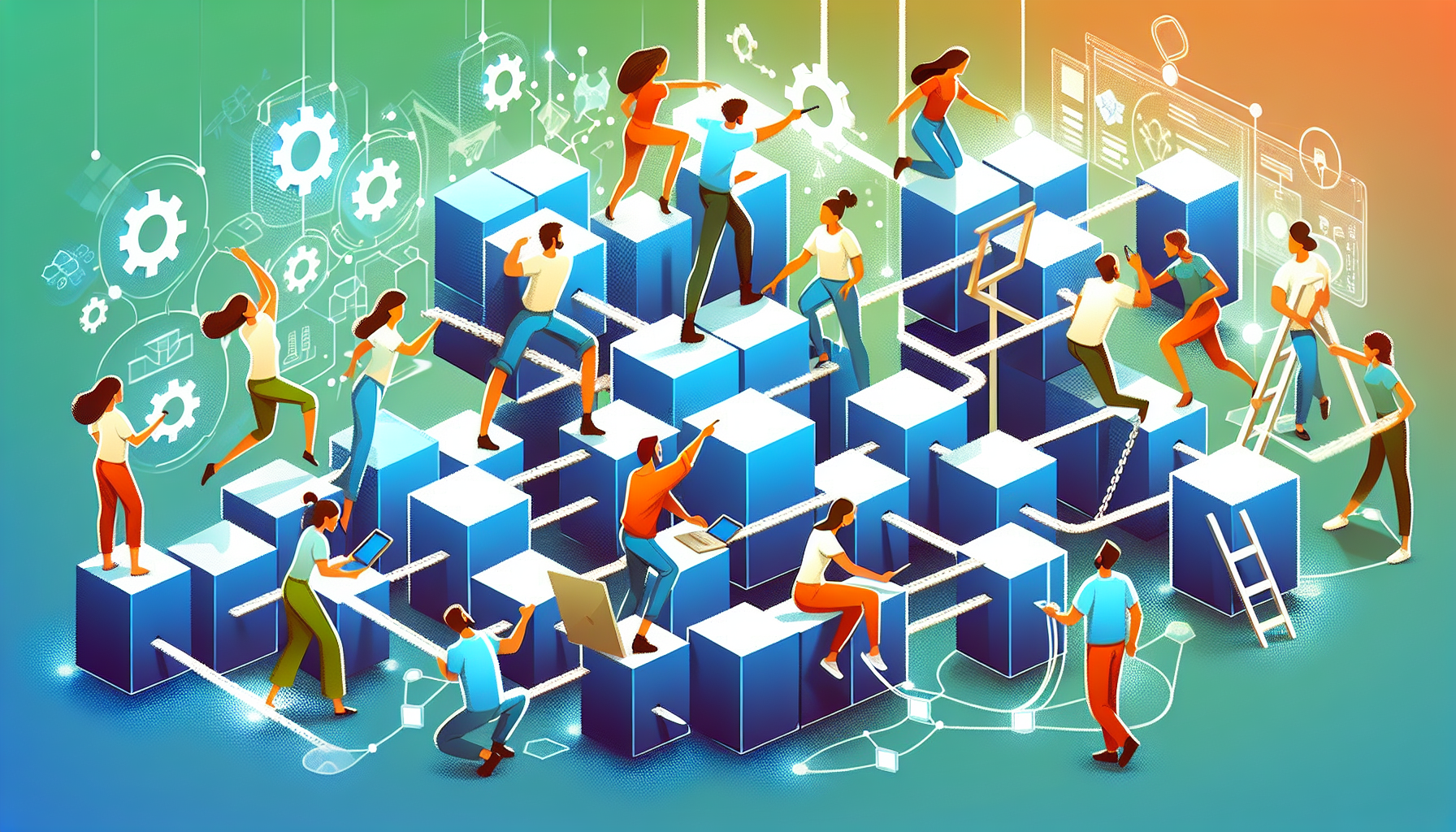Wondering how to implement agile methodologies in blockchain development projects? Decentralized applications (dApps) are a key component of blockchain development, offering innovative solutions that leverage the decentralized nature of blockchain technology. This article demystifies the process, offering a step-by-step roadmap for adapting the iterative and incremental development practices of agile to the unique dynamics of blockchain technology. Get ready to discover practical applications of agile principles that will transform your team’s efficiency, collaboration, and ability to meet evolving project demands head-on.
Agile methodologies enhance blockchain development by fostering collaboration, flexibility, and user-focused innovation, tailoring agile principles to specific challenges and incorporating user feedback early in the process.
Effective agile blockchain teams require cross-disciplinary collaboration, clear roles, responsibilities, and a strong culture of communication to navigate the unique challenges of decentralized technology.
Iterative and incremental development, continuous integration, and regular retrospectives are crucial for evolving blockchain projects to meet user needs, with performance metrics and agile frameworks serving as tools to measure and guide success.
Embracing Agile Principles in Blockchain Development

Agile methodologies are not just a buzzword; they are a transformative force in the blockchain arena. By promoting collaboration, flexibility, and adaptability, agile methodologies and DevOps practices enhance every facet of blockchain development. From smart contract creation to full-scale blockchain solutions, the agile ethos is reshaping how projects unfold in this space. Agile’s principles of iterative and incremental development align perfectly with the needs of blockchain technology, allowing for continuous improvement and adaptation.
Let’s peel back the layers and examine how the agile approach aligns with blockchain technology and the remarkable benefits it brings to the table.
Understanding the Agile Manifesto
At the heart of agile methodologies lies the Agile Manifesto—a beacon that guides software development with principles centered on customer satisfaction, adaptability, and continuous improvement. Sprint planning is a key component of the Agile Manifesto, ensuring that teams can effectively plan and execute iterations, which is crucial for the dynamic nature of blockchain projects. The Agile Manifesto emphasizes iterative and incremental development, allowing for flexibility and adaptation to the ever-evolving technology of blockchain. It’s a manifesto that doesn’t just apply to traditional software but is equally pertinent to blockchain projects, where user stories often dictate the direction of development.
As we embrace change with open arms, the agile approach ensures that blockchain technologies remain relevant, responsive, and resolutely user-focused.
Customizing Agile for Blockchain Challenges
The blockchain landscape, with its unique challenges, demands an agile methodology that’s tailored to its intricacies. From smart contract development to the deployment of blockchain applications, agile practices are not just an adjunct but a cornerstone that supports the burgeoning blockchain space. Iterative and incremental development, including practices like test-driven development, can be customized to address the specific challenges of blockchain, allowing for continuous adaptation and improvement.
As agile methods infiltrate the blockchain domain, they reveal opportunities for more flexible and responsive solutions, proving that even in the most complex projects, agility is not just possible but profoundly advantageous.
Incorporating User Feedback Early and Often
In the fast-paced world of blockchain projects, incorporating user feedback through user stories is not an afterthought but a guiding principle of agile methodologies. It’s the lifeblood of iterative development, ensuring that blockchain technologies evolve in lockstep with user needs and expectations. Iterative and incremental development ensures that user feedback is continuously integrated into blockchain projects.
By establishing open communication channels and fostering enhanced collaboration, agile teams are adept at weaving user insights into the fabric of blockchain applications, leading to products that resonate deeply with their user base.
Structuring Your Agile Blockchain Team

Assembling an agile blockchain team is akin to curating a group of maestros, each bringing their unique expertise to the symphony of blockchain development within a collaborative environment. The structure of such a team is crucial, requiring a blend of cross-functional skills, clearly defined roles, and a culture of open communication. Iterative and incremental development guides the team’s work, allowing for flexibility and adaptation to the ever-evolving technology of blockchain.
In the following sections, we’ll explore how to build a team that not only understands the agile methodology but also thrives within the decentralized ethos of blockchain technology.
Building Cross-Functional Teams
Cross-functional teams are the engines of innovation in agile blockchain projects. Pair programming can enhance collaboration within cross-functional teams by allowing two developers to work together at one workstation, thereby improving code quality and fostering knowledge sharing. By bringing together professionals from various disciplines—smart contract developers, cryptography experts, and system architects—these teams are uniquely equipped to navigate the multifaceted nature of blockchain challenges. Such diversity not only accelerates problem-solving but also enriches the project with a multitude of perspectives, ensuring a well-rounded and robust blockchain solution. Additionally, iterative and incremental development benefits from the diverse expertise within cross-functional teams, allowing for greater flexibility and adaptation to the evolving technology of blockchain.
Roles and Responsibilities
In the decentralized world of blockchain, clarity in roles and responsibilities is paramount, with the product owner playing a key role in defining and refining these responsibilities within the team. It establishes a sense of trust and accountability within the team, with each member understanding their contribution to the blockchain project’s lifecycle. Performance metrics serve as the compass, guiding team members in fulfilling their responsibilities and maintaining the integrity of the development process. Iterative and incremental development helps in defining and refining these roles over time.
This clear delineation of duties not only streamlines workflows but also reinforces the collective commitment to the project’s success.
Enhancing Communication and Collaboration
The essence of agile methodologies in blockchain development is rooted in open communication and robust collaboration. Daily stand-ups facilitate open communication and quick problem-solving by allowing team members to share updates and address issues promptly. By fostering a culture where knowledge sharing is the norm, agile teams can quickly identify and address challenges, keeping the project’s momentum steady and strong. Iterative and incremental development fosters continuous communication and collaboration, ensuring that teams remain adaptable and responsive to changes.
Regular scrum meetings serve as the pulse points, ensuring that all team members are aligned and engaged, while stakeholder engagement provides a continuous stream of valuable insights.
Implementing Iterative Development in Blockchain

Iterative and incremental development is the linchpin of agility in blockchain projects. A minimum viable product (MVP) is a key concept in this approach, allowing teams to release a basic version of the product to gather feedback and make iterative improvements. It allows for a flexible approach to development, accommodating changes, and enhancing the project progressively. This method is particularly well-suited for blockchain’s decentralized environments, where cross-functional teams work in concert to foster rapid development and innovation.
In the subsequent sections, we delve into the specifics of planning in short iterations, embracing change through continuous integration, and the importance of conducting regular retrospectives in the context of development processes.
Planning in Short Iterations
Short iterations are the stepping stones toward achieving a lean and responsive blockchain project. They allow teams to:
Pivot quickly
Refine their approach based on real-time feedback
Provide a platform for innovation
Ensure that resources are allocated to features that truly resonate with customers
Backlog refinement supports planning in short iterations by ensuring that the team continuously reviews and prioritizes tasks, making the planning process more efficient and focused.
Planning in short iterations is a core component of iterative and incremental development.
This agility is particularly useful for startups in the blockchain ecosystem.
By embracing an iterative approach, blockchain startups can progressively enhance their applications, fostering a culture of continuous delivery and improvement.
Embracing Change through Continuous Integration
Continuous integration stands as a testament to the agile principle of embracing change. In blockchain development, CI/CD pipelines serve as the arteries, pumping new features and improvements into the project’s heart with speed and precision. To ensure a smooth and efficient workflow, it is crucial to implement continuous integration in the development process, with automated testing being a crucial component that supports CI. Continuous integration supports iterative and incremental development, allowing for flexibility and adaptation to the ever-evolving technology of blockchain.
Automated testing and deployment, facilitated by tools such as Docker and Kubernetes, ensure that blockchain applications are modular, scalable, and ready to adapt to the ever-evolving demands of the market.
Conducting Regular Retrospectives
Regular retrospectives are an opportunity for agile blockchain teams to pause and reflect, with a key goal of process improvement. They are not about finger-pointing but about fostering a culture of continuous improvement. By assessing the development process and identifying areas for enhancement, teams can streamline their workflows and bolster productivity for future sprints.
It’s a practice that not only strengthens the team’s dynamics but also ensures that the project remains on a trajectory toward success. Regular retrospectives are crucial for iterative and incremental development, allowing teams to adapt and refine their approach continuously.
Agile Project Management Tools and Techniques

The arsenal of agile project management is replete with tools and techniques designed to streamline the blockchain development process. From Kanban boards and other visual aids that provide real-time progress tracking to sophisticated frameworks that guide the development lifecycle, these instruments are indispensable for agile teams. Agile project management tools and techniques support iterative and incremental development, allowing for flexibility and adaptation to the ever-evolving technology of blockchain.
In the sections that follow, we’ll examine:
How frameworks like Scrum and Kanban facilitate tracking
The role of technology in enhancing efficiency
The importance of performance metrics in gauging success.
Tracking Progress with Agile Frameworks
Agile frameworks such as Scrum and Kanban, along with tools like burndown charts, offer a tailored approach to tracking progress in blockchain projects. Scrum, with its well-defined cycle, brings structure and regularity, while Kanban’s visual boards offer a snapshot of the project’s flow. These frameworks are not static; they are adapted to fit the unique contours of a blockchain project, ensuring that teams have a clear understanding of where they are and where they need to go. Tracking progress with Agile frameworks supports iterative and incremental development, allowing for flexibility and adaptation to the ever-evolving technology of blockchain.
Measuring Success with Performance Metrics
In the world of agile project management, performance metrics like velocity are the yardstick by which success is measured. Key performance indicators such as customer satisfaction and user adoption provide tangible evidence of a project’s impact. Tools like Axosoft offer visual representations like burndown charts, enabling teams to graph their progress and predict completion dates with greater accuracy. Measuring success with performance metrics supports iterative and incremental development by allowing teams to adapt and refine their approach based on real-time data.
Whether it’s through sprint burndown reports or epic and release burndown charts, these metrics ensure that agile teams have a clear vision of their trajectory.
Adapting Agile Practices for Smart Contract Development

Agile practices are not only adaptable but also essential in the realm of smart contract development. Refactoring is essential in the iterative development of smart contracts, ensuring that the code remains clean, efficient, and adaptable to new requirements. They provide the framework for continuous improvement, collaboration, and security that is paramount for successful blockchain applications. Adapting Agile practices for smart contract development benefits from iterative and incremental development, allowing for flexibility and adaptation to the ever-evolving technology of blockchain.
In the ensuing sections, we will explore:
The iterative nature of smart contract creation
The importance of stakeholder collaboration in decentralized governance
The integral role of security experts in the development process.
Iterative Smart Contract Creation
The creation of smart contracts is a journey best navigated through iterative development. Code reviews enhance the quality and security of smart contracts by identifying potential vulnerabilities and ensuring adherence to best practices. Agile smart contracts are built on a bedrock of continuous feedback, allowing for the fine-tuning of elements such as functionality and security. This approach not only enhances collaboration and accountability but also ensures that smart contracts are robust, secure, and aligned with stakeholder interests. Iterative smart contract creation is a prime example of iterative and incremental development, which allows for flexibility and adaptation to the ever-evolving technology of blockchain.
Collaborating with Stakeholders for Decentralized Governance
Decentralized governance is a hallmark of blockchain technology, and governance protocols are key to its success. Governance protocols on platforms like Ethereum enable a democratic approach to decision-making, where the input of every member is valued.
By involving stakeholders such as developers, regulators, and auditors, smart contract governance becomes a transparent and accountable process, reflecting the collective will of its participants. This collaborative approach benefits significantly from iterative and incremental development, allowing for continuous improvement and adaptation to the evolving needs of decentralized governance.
Integrating Security Experts in the Development Process
In the intricate world of smart contract development, security audits are a crucial practice for ensuring the security of smart contracts, with security experts acting as the guardians at the gate. They play a pivotal role in preventing unauthorized access and ensuring that potential vulnerabilities are effectively addressed. Automated security testing tools integrated within CI/CD pipelines are an essential layer of defense, continually scrutinizing smart contracts for weaknesses and fortifying the overall security of blockchain applications. Integrating security experts in the development process supports iterative and incremental development, allowing for continuous improvement and adaptation to new security challenges.
Case Studies: Agile Blockchain Success Stories
The transformative power of agile methodologies in blockchain development is not merely theoretical; it is evidenced by a myriad of success stories across various industries. Real-world applications demonstrate the success of agile methodologies in blockchain by showcasing practical implementations and outcomes. These real-world examples demonstrate how agile practices can revolutionize traditional processes, facilitating secure, transparent, and decentralized transactions. The principles of iterative and incremental development have played a crucial role in these success stories, allowing for flexibility and adaptation to the ever-evolving technology of blockchain.
In the following sections, we’ll highlight some of the most compelling case studies in supply chain management and financial services, showcasing the tangible benefits of agile blockchain development.
Supply Chain Management Innovations
Blockchain platforms are revolutionizing supply chain management innovations. IBM’s blockchain platforms, like TradeLens, have significantly improved the visibility and efficiency of supply chain transactions. PepsiCo’s Project Proton, by leveraging Agile Smart Contracts, was able to enhance the efficiency of its ad supply chain substantially. Supply chain management innovations also benefit from iterative and incremental development, allowing for continuous improvement and adaptation.
These examples underscore the potential for blockchain to streamline complex processes and deliver tangible business benefits when underpinned by agile methodologies.
Transformative Potential in Financial Services
The financial services sector stands on the brink of a paradigm shift, thanks to the transformative potential of agile blockchain development and decentralized finance (DeFi). While specific success stories in this sector are not explicitly noted, the alignment of agile practices with strategic goals in blockchain initiatives is indisputable. The transformative potential in financial services also benefits from iterative and incremental development, allowing for flexibility and adaptation to the ever-evolving technology of blockchain.
The result is a more adaptive, responsive financial ecosystem, capable of evolving with industry demands and technological advancements.
Summary
We have traversed the landscape where agile methodologies meet blockchain development, exploring the myriad ways in which this synergy drives innovation, enhances collaboration, and fosters a culture of continuous improvement. Agile transformation drives innovation in blockchain development by enabling teams to quickly adapt to changes and continuously deliver value. Agile practices are not just compatible with blockchain technology; they are the catalysts that propel these projects to new heights, ensuring that they are responsive, user-centric, and secure. As we look to the future, the integration of agile principles in blockchain development promises to unlock even greater potential, leading to more efficient, transparent, and decentralized solutions. The principles of iterative and incremental development in Agile methodologies are crucial for adapting to the ever-evolving technology of blockchain.
Frequently Asked Questions
How do agile methodologies specifically benefit smart contract development?
Agile methodologies benefit smart contract development by emphasizing adaptability and incremental delivery, which allows for continuous feedback and iteration to meet user needs and maintain high security standards.
What role do security experts play in agile blockchain projects?
Security experts play a crucial role in agile blockchain projects, as they are responsible for preventing unauthorized access and addressing potential vulnerabilities by conducting security audits and using automated testing tools. Their involvement ensures the security of smart contracts and blockchain applications.
Can agile practices be adapted to the unique challenges of blockchain projects?
Yes, agile practices can be adapted to address the unique challenges of blockchain projects by customizing the approach to fit the complex requirements, reducing risks, and enhancing collaborative efforts.
Posted in Blockchain, Technologies





